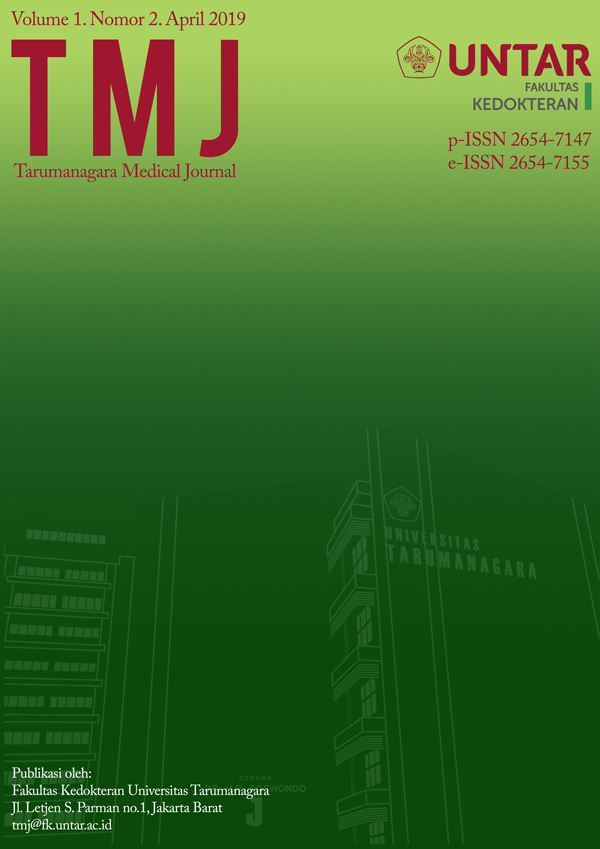Efek antimikroba air kelapa terhadap pertumbuhan bakteri Salmonella typhi
Main Article Content
Abstract
Salmonella typhi adalah salah satu penyebab diare terbesar setelah E. coli. Diare yang disebabkan Salmonella typhi adalah diare invasif dengan karakteristik demam panjang, nyeri perut, dan manisfestasi sistemik lainnya (delirium, sakit kepala). Salah satu penanganan diare yang sering dilakukan oleh masyarakat adalah dengan mengonsumsi air kelapa. Di Indonesia terdapat 2 jenis kelapa yang sering dikonsumsi, yaitu kelapa hijau (Cocos nucifera L var viridis) dan kelapa coklat (Cocos nucifera L var rubescens). Penelitian dengan metode deskriptif potong lintang ini bertujuan untuk mengetahui efek air kelapa terhadap pertumbuhan Salmonella typhi. Sampel yang digunakan adalah air kelapa dari 6 buah kelapa hijau dan air kelapa dari 6 buah kelapa coklat yang didapatkan dari daerah Ciapus, Bogor. Hasil penelitian menunjukan terbentuknya zona bening pada kedua jenis dan usia kelapa. Analisa lebih lanjut tidak terdapat perbedaan efek yang signifikan antara jenis kelapa (p-value = 0,257) dan umur kelapa (p-value = 0,257).
Article Details
Penulis yang menerbitkan artikelnya di Tarumanagara Medical Journal (TMJ) setuju dengan ketentuan sebagai berikut:
- Penulis mempertahankan hak cipta dan memberikan jurnal hak publikasi pertama dengan bekerja secara bersamaan dilisensikan di bawah Creative Commons Attribution yang memungkinkan orang lain untuk berbagi karya dengan pengakuan atas kepengarangan dari karya asli dan publikasi dalam jurnal ini.
- Penulis dapat masuk ke dalam pengaturan kontrak tambahan yang terpisah untuk distribusi non-eksklusif jurnal versi pekerjaan yang dipublikasikan (misalnya, memposting ke repositori institusional atau menerbitkannya dalam buku), dengan pengakuan publikasi awal dalam jurnal ini.
- Setiap teks yang dikirim harus disertai dengan "Perjanjian Transfer Hak Cipta" yang dapat diunduh melalui tautan berikut: Unduh
References
Kaur A, Kapil A, Elangovan R, Jha S, Kalyanasundaram D. Highly-sensitive Detection of Salmonella typhi in Clinical Blood Samples by Magnetic Nonparticle-based Enrichment and in-situ Measurement of Isothermal Amplification of Nucleic Acids. PLOS ONE. 2018 Nov;13(9)
Kasper D, Fauci A, Longo D, Jameson J, Loscalzo J, Hauser S. Harrison’s Principles of Internal Medicine. Edisi 19, volume 1. New York: Mc Graw Hill Education, 2015. Halaman: 268-72
Feldman M, Lawrence S, Brandt L. Sleisenger and Fordtran's Gastrointestinal and Liver Disease. 10th Edition. Philadelphia: Elsevier, 2016. Chapter 110. Halaman: 1907
The Treatment of Diarrhoea [Internet]. World Health Organization. World Health Organization; 2011 [cited 2015 September 11th]. Available from: https://www.who.int/maternal_child_adolescent/documents/9241593180/en/
Diarrhea in Adults [Internet]. Antimicrobe. [cited 2016 October 2nd] Available from: http://www.antimicrobe.org/e17.asp
Macam-Macam Kelapa [Internet]. Ilmu Biologi RSS. [cited: 2018 Mar 17th].
Agroforestree Database: a tree reference and selection guide version 4.0 [Internet]. 2009. [cited 2016 October 2nd]. Available from: http://www.worldagroforestry.org/sites/treedbs/treedatabases.asp
Mandal SM, Dey S, Mandal M, Sarkar S, Maria-Neto S, Franco OL. Identification and Structural Insights of Three Novel Antimicrobial Peptides Isolated from Green Coconut Water. Peptides, 2009; 30(4): 633–7.
Rodriguez JJG, Zarzosa AO, Gomez RL, Meza JEL. Plant Antimicrobial Peptides as Potential Anticancer Agent. BioMed Research International. 2015. Available at: https://www.hindawi.com/journals/bmri/2015/735087/
Tam J, Wang S, Wong K, Tan W. Antimicrobial Peptides from Plants. Pharmaceuticals. 2015;8(4): 711-57.
Silva ON, Porto WF, Migliolo L, Mandal SM, Gomes DG, Holanda HHS. Cn-AMP1: A New Promiscuous Peptide with Potential for Microbial Infections Treatment. Biopolymers. 2012; 98(4): 322-31.
Parys AV, Boyen F, Verbrugghe E, Leyman B, Bram F, Haesebrouck F, et al. Salmonella Typhimurium Induces SPI-1 and SPI-2 Regulated And Strain Dependent Downregulation of MHC II Expression on Porcine Alveolar Macrophages. VetRes. 2012: 43(1): 52.
Winter SE, Winter MG, Poon V, Keestra AM, Sterzenbach T, Faber F, et al. Salmonella enterica Serovar Typhi Conceals the Invasion-Associated Type Three Secretion System From the Innate Immune System by Gene Regulation. PLoS Pathogens. 2014 Mar; 10(7)
Dalebroux Z, Rdrozo M, Pfuetzner R, Ressl S, Kulasekara BR, Blanc MP et al. Delivery of Cardiolipins to the Salmonella Outer Membrane is Necessary for Survival within Host Tissue and Virulance. Cell Host & Microbe. 2015; 17(4): 441-51.



